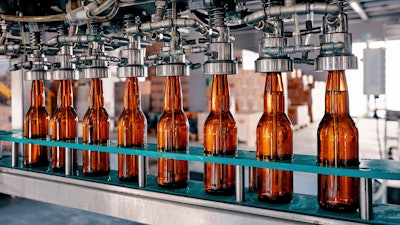
Product shortages, shipping delays, and safety concerns have made it difficult to get products from nearly all manufacturers to consumers during the COVID-19 pandemic. The food supply chain has been hit particularly hard; for example, one McKinsey report revealed that over one-third of pork and beef processing capacity became unavailable around July 2020.
Although the ship has begun righting itself slowly, recent food and beverage supply chain challenges should serve as a reminder that there’s always room to improve critical food infrastructure. A steady and secure food supply chain can help build back consumer confidence while strengthening the economy. With consumer spending expected to grow by 7.6% this year and another 3.9% in 2022, food processors and manufacturers need more readily available products to capitalize on increasing demand.
To minimize further disruptions and strengthen critical food infrastructure, businesses in the food supply chain should consider investing in improvements that support resiliency. Using insights from a strengths, weaknesses, opportunities, and threats analysis can lend insights into where to focus attention. What is the biggest weakness in operations that could threaten business should conditions take another turn for the worse?
 iStock
iStock
Overcoming Food Supply Chain Problems
Businesses will have different gaps to fill, but a few investments can help companies overcome food and beverage supply chain challenges across the board. Investing in equipment, for example, is the most apparent — many companies in the industry are turning to robotics and automation to reduce operating costs, increase food safety, and improve throughput. Such investments often occur alongside renewed talent acquisition efforts focused on recruiting workers who can leverage modern technology, equipment, and strategies.
However, one of the greatest challenges behind any improvement effort is funding, which is especially true amid the pandemic. Market conditions remain uncertain, the cost of raw materials is still on the rise, and increasing spending to ensure employee safety doesn’t always make businesses in the food supply chain attractive investment candidates.
But funding options are available to help companies improve critical food infrastructure and build more resilience into the food supply chain. Consider the following:
1. Grant programs.
President Biden’s “Build Back Better” initiative is rolling out now on the federal level — and more than $4 billion is earmarked to strengthen critical food infrastructure in areas like production, processing, and distribution. Funding will include a mix of food processing and manufacturing grants, loans, and other financing mechanisms.
On the state level, programs are also available to support new investments that help businesses overcome food and beverage supply chain challenges. States such as California, Washington, and Michigan, for example, have offered grant opportunities geared specifically toward helping food processors make new equipment purchases.
2. Private financing.
Most businesses in the food supply chain understand that they can take out a loan, use credit, or even borrow money from those in their network to fund improvements. All can be practical options, but there are others you might not have considered.
Equity financing, for one, can be a viable alternative for businesses, and particularly those in the market to sell within the next three to five years. In cases where the intent is to sell within this time frame, equity investors receive no return and are only paid based on their ownership percentage at the time of sale — unless the equity is convertible to debt and paid off in dividends or interest. All parties must agree upon this arrangement before the investment.
If equity financing isn’t doable, there’s also the option of subordinated debt, or “subdebt,” which holds a subordinate position to other debt. It works like a traditional loan where businesses pay a fixed monthly interest rate and interest/principal payments on the debt. But the interest rate is often higher (anywhere from 6% to 12%), as this lender wouldn’t be paid until all other lenders are paid should you liquidate the business.
Beyond that, another alternative is royalty participating debt. Instead of a loan, the money provided serves as an investment. Investors receive monthly payments based on a percentage of gross revenue for a set time frame. A drawback with this arrangement comes down to payments. It can be difficult for businesses in the food supply chain to afford the “royalties” without a high gross profit margin — at least 25% is recommended.
3. Cooperatives.
Grower-owned and similar cooperatives have long been a way to give growers and other stakeholders more control over supply chain concerns ranging from supplies and services to value-added production to marketing and distribution. When properly organized and managed, a cooperative can provide value in terms of availability of supplies, costs, and overall understanding of their owners’ critical business needs.
There are many consultants, law firms, and others that can help in the formation and development of a cooperative. A good starting point might be a cooperative development center. Most states have one or more, and rural cooperative development centers can be found on this list published by the Department of Agriculture’s Rural Development segment.
The Final Word
As we’ve all learned recently, disruption is inevitable. It’s more important than ever for food processing and manufacturing companies to improve operations and help create a more stable food supply chain. Once you’ve identified your business’s weakest areas, find the right financing options to help improve them.
 Toni Scott
Toni Scott






















